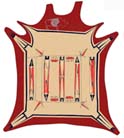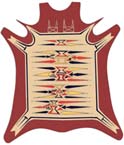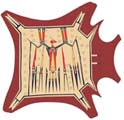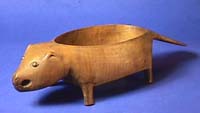
 1 |
 2 |
 3 |
||
 4 |
Painted deer hides attributed to Illinois Indians pre-1796
1. Arrowhead and broken diamond motif. enlarge |
|||
[Bison hair] . . . falls off in Summer, and The skin becomes as soft as Velvet. At that season, the savages Use the hides for making fine Robes, which they paint in various Colors. (Jacques Marquette, 1674)![]()
The Illinois engaged in many different kinds of decorative arts. Among these were hide painting, weaving, fabric dying, quillworking, and wood carving. Unfortunately, many of the artistic traditions of the Illinois were lost during the historic era. Today, only a handful of art objects are preserved in museum collections.
Hide paintings were applied to the skins of bison, deer, and other animals using red, yellow, and black paint. Four hide paintings attributed to the Illinois Country are preserved at the Musée de l'Homme (Museum of Man) in Paris, France. Two design themes recur on all four hides. First, each painting is bordered by a narrow, black line that parallels the outer edge of the hide. In three of the four paintings, this line seems to depict the limbs and neck of a four-legged animal--one of which has cloven hooves like those on a bison or a deer. The bordering line appears to represent the outer edge of a dressed animal hide, suggesting that the paintings are representations of hide paintings. The second design theme consists of long, narrow triangles or polygons arranged in abstract patterns. The triangles sometimes incorporate pointed elements that may represent arrowheads and single-barbed spear points. One painting seems to portray the thunderbird, a deity honored by the Illinois for its supernatural powers. Another shows a naturalistic image of a bison bull standing near a dome-shaped structure, perhaps a wigwam.
The Illinois applied red, yellow, and black paints to reed mats that were laid out on the ground for calumet dances and other special occasions. The same three colors were used to paint feathers attached to calumet pipes. The Illinois also used red, yellow, and gray dyes to decorate scarves, belts, and garters woven from the hair of bears and bison. Before glass trade beads became widely available, the Illinois decorated their head bands and moccasins with dyed porcupine quills.
Wood-carving was an important means of artistic expression among the Illinois, although only a few wooden objects have survived in museum collections. Two highly respected pieces are wooden effigy bowls carved to look like beavers. The bowls stand on four legs, have flat tails, and, in one case, have eyes inset with brass tacks.
![]()
Wooden bowl carved in the form of a beaver; eyes inset with brass tacks. Kaskaskia Tribe, pre-1797.
![]()
|
|
Copyright © 2000 Illinois State Museum
